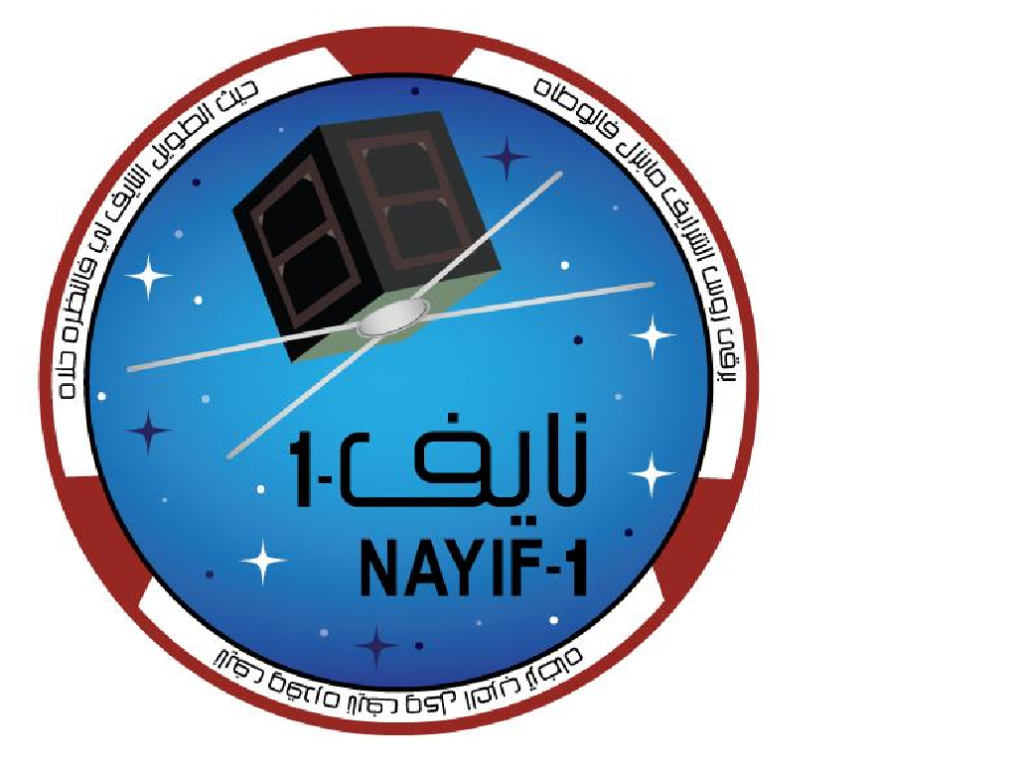
As everyone is aware, Solar Cycle 25 has already shown that we cannot yet predict what the sun will be doing with any great accuracy.
Sunspots, X-class solar flares and CMEs (coronal mass ejections) are increasing in frequency and intensity on a daily basis.
The peak of Solar Cycle 25 was not expected until late 2024 or early 2025 but it may be coming earlier and have a higher intensity than was predicted.
One result of this increased activity is that the upper atmosphere and ionosphere of the earth becomes warmer and expands upwards. This means that spacecraft in low earth orbit experience more drag or resistance as a result of the increase in the number atoms they are having to displace as they travel around the globe. As a consequence, the spacecraft loose more kinetic energy and start to descend lower in orbital height, which, of course, makes the problem worse and a fiery end to the spacecraft is hastened.
The actual effect is also dependant on the drag coefficient of the particular spacecraft…simply how much mass (the more the better) to how much surface area (the less the better). So in CubeSat terms, a 1U CubeSat, fairly full of stuff with a mass near the maximum of 1.3kg, will probably be better off than a half empty 3U CubeSat with deployable solar panels and other drag inducing protuberances.
All TLEs (Two Line Elements) include a parameter called drag, it is usually a very small number preceeded by four or more zeros! Although this parameter is calculated by the system, it is not usually precise or even stable, so cannot be used to accurately predict deorbit dates when looking forward many weeks/months. It can give us a guide though! Alarm bells should ring when we only see two leading zeros.
How does this effect our activities? Well for the FUNcube family, there are presently three active members!
FUNcube-1, AO73 was launched almost ten years ago in November 2013 into an elliptical polar orbit of approx 682×595 km. Presently those numbers are around 640×570 km so probably not too much to worry about. The drag number from the TLEs is, at the time of writing, 0.000074, a good number.
The same applies to JY1SAT, JO-97. This was launched in December 2018 into a 573×590 km polar orbit. Presently those numbers are around 557×573 km and the current drag is listed as 0.000076.
Unfortunately, however, the same cannot by said for Nayif-1, EO88. This spacecraft was launched in February 2017 into a 496×507 km polar orbit. Currently the orbit parameters show a height of around 320 km with the drag at 0.00319. It is now well below the ISS and much lower than at launch.
As mentioned, largely due to the random nature of the our star’s flux output on a day to day basis, it is not possible at this stage to accurately predict the likely deorbit date but it seems that it will certainly be before the end of this year. As the spacecraft continues to perform 100% nominally this is a great shame. Presently it is switching autonomously from high power telemetry when in daylight and with lower power telemetry and the transponder active when in darkness. The solar panels, battery and power system also continue to be reporting nominal numbers, essentially unchanged since the day of launch.
It will therefore be a really sad moment when re-entry occurs but in the meantime everyone is encouraged to use the spacecraft whilst it remains available.
To mark the event of EO88/Nayif’s demise, AMSAT-UK is offering two awards. These will be individual framed certificates.
Firstly, to the station who submits the last telemetry to the FUNcube Data Warehouse and also to who “guesses” or calculates the re-entry time and date most accurately. Submissions for this award must be made to EO88@amsat-uk.org before midnight (UTC) on July 4th 2023. So time is short to get your entries in. Good luck!
Another year has passed and FUNcube 1 has continued to operate from its orbit around 600km above the earth. To start with some statistics. The spacecraft creates and downlinks data in frames that run for two minute periods. It has now transmitted more that 16 million of these frames or “Sequence Numbers”. Another big statistic is that more than 10 million data packets have been received by stations that have forwarded them to our Data Warehouse. You can see the leading groundstations here http://warehouse.funcube.org.uk/ui/fc1-fm/satellite_ranking – special congratulations to those at the top scorers…many of them have individually forwarded more than 1 million packets. Thanks to all contributors around the world. Having this network of groundstations has enabled us to easily monitor the status of the spacecraft easily.
Back here on earth, as mentioned, we have continued to monitor the health of the spacecraft as these illumination levels and spin/tumble rates have changed over the months.
Whilst mentioning big numbers, we are now approaching 48500 orbits and this equates to a distance travelled of 2174091840000000000000000000 fermis since launch. That’s 2.1 ronnafermis. Yes these are genuine SI Units of Measure and are equivalent to 14.16 AU or almost half way to Neptune.
After some time in full sun, the spacecraft is now experiencing “normal” eclipse periods of around 25 minutes each orbit. This will reduce the on board temperatures and may influence the tumble rate which has been between 2 and 5 seconds for some time. The is quite fast and is not helping telemetry reception with our 5 second data frame mentioned above.
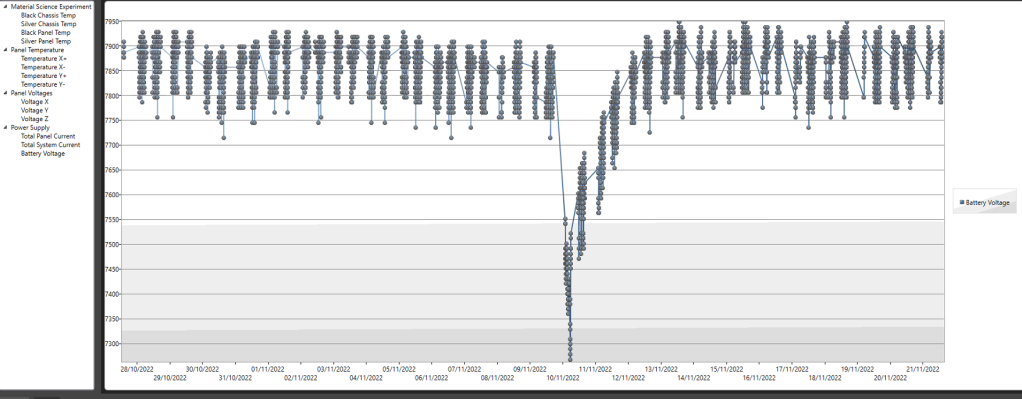
The present operational schedule is for high power telemetry when in sunlight and receive only when in eclipse. This seems to suit the EPS quite well and the battery bus voltages have been quite stable.
At least that was correct until early morning on Friday 11th November when the indicated bus voltage appeared to “drop off a cliff” over the period of just four orbits. Further analysis showed that the 3.3V bus consumption had suddenly jumped four times normal. As can be seen by the graph above this problem then disappeared just as suddenly and the bus voltage recovered quite quickly. Investigations are continuing!
Please keep the telemetry reports coming in and let us know if you would like a Fitter message uploaded for any educational or outreach events.
Many will be aware that FUNcube-1 has been transmitting a special Fitter message to commemorate her Majesty the Queen’s Platinum Jubilee earlier this month. Everyone who receives this message and uploads it to the Data Warehouse using the Dashboard can generate a certificate to remember this historic event. The special message includes a link to a website that has the full instructions. It is intended to keep this message active until the end of June.
The spacecraft’s orbit continues to run near the sun’s terminator and this may be resulting in less than optimal solar power generation. The battery bus voltage is now centred around 7.45 volts rather than the 8+ volts that we have seen for many years. We believe that this reduced voltage level may be due to a combination of factors, illumination levels, battery and/or solar panel degradation or, possibly, gradual changes in some component values within the EPS. It is also possible that the high spin/tumble rates that we experienced over the recent months may be involved. Our thanks to to Colin VK5HI and his team for continuing to keep track of this issue for us.
Operators may have noticed that the spacecraft is now in high power telemetry mode when in sunlight and in receive only mode during eclipse. Although the transponder is not currently active, with the rapid fading presently being experienced on the downlink, the high-power telemetry setting will assist listeners to decode the data more easily.
We continue to be extremely grateful to all those stations who continue to contribute their data to the FUNcube data warehouse. The information you are providing is invaluable to the FUNcube to team and will greatly assist us in managing the spacecraft through its “middle age” after more than eight years in space!
Nayif-1 (EO-88) was launched at 03:58 UTC on February 15th 2017 on a PSLV launcher from India. It was part of a world record launch as the C37 flight carried 104 spacecraft into orbit.
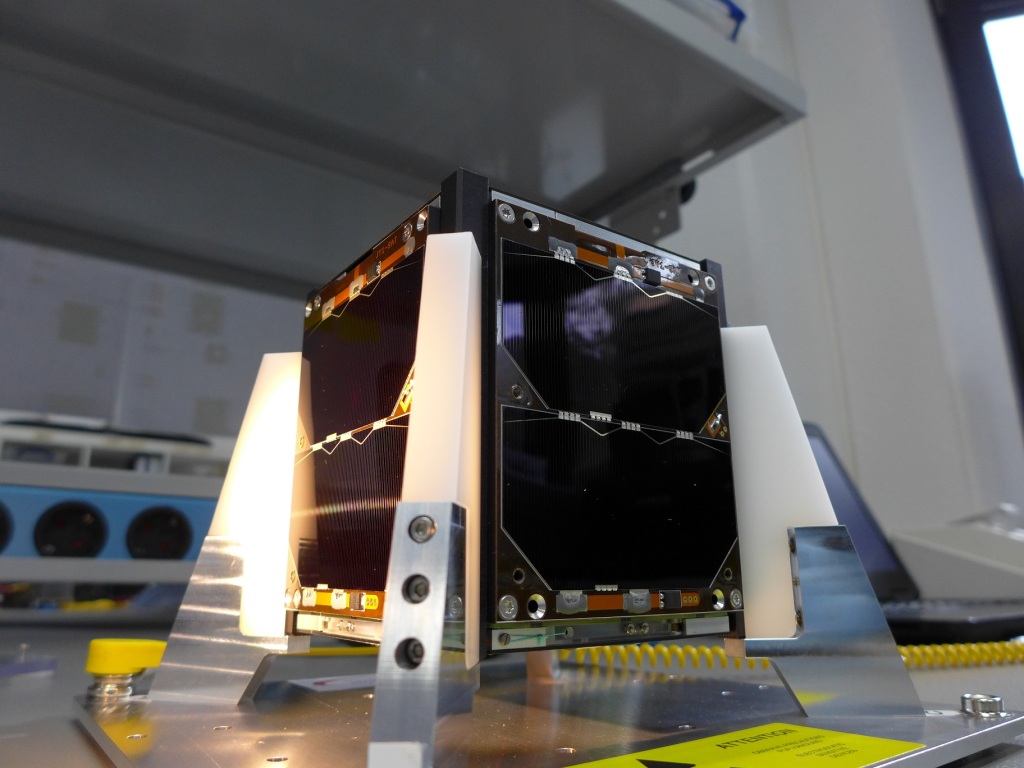
The transmitter was autonomously activated around 04:47 UTC and the first signals were received and decoded a few minutes later by KB6LTY and within a few hours more than 250 stations around the world had submitted telemetry reports to the Data Warehouse.
After more than 27500 orbits of the earth, the spacecraft continues to function nominally. It switches between high power telemetry when in daylight to low power telemetry and transponder when in eclipse.

The mission was developed by the Mohammed bin Rashid Space Centre (MBRSC) and American University of Sharjah (AUS). The UAE’s first Nanosatellite was developed by Emirati engineering students from AUS under the supervision of a team of engineers and specialists from MBRSC within the framework of a partnership between the two entities, aiming to provide hands-on experience to engineering students on satellite manufacturing.
There are presently three FUNcube based missions in orbit – currently all of them have active, linear U/V transponders. The current status of each of these can always be checked on the useful AMSAT-NA status page https://www.amsat.org/status/ and an update on each of them is provided below. Please have FUN using them!
AO73 – FUNcube1. As previously reported AO73 appears to be experiencing some power issues after 8+years in orbit.
The battery is not charging to the same voltage as it did up to early November last year. The spacecraft has experienced many months of continuous sunlight over the past couple of years and this has resulted in high (around +30C) onboard temperatures. This environment may have “cooked” the cells although presently we do not see any direct evidence of this.
We can see that the stable bus voltage indicated at the end of charge is now much lower and depends on the current being taken by the on-board systems. The solar panel currents appear to be similar to those recorded soon after launch. The current best theory is that we are seeing the effect of some increased resistance in the supply circuit between the eps charging circuit and the battery. Although we do not have access to a fully detailed circuit diagram of the EPS we believe that there is an “ideal diode” in this line to prevent discharge of the battery back through the EPS circuitry. We understand that this is actually a MOSFET device and the suspicion is that this may now be showing signs of radiation damage.
So an operational mode has been selected that can be hopefully sustained for some time. From today AO73 is in continuous transponder mode and is available for use 24/7. Low power telemetry is also being transmitted and reports of the data are very welcome via the FUNcube Data Warehouse. Please remember that the uplink frequency varies with on board temperatures. A lower temperature means a higher frequency!
EO88 – Nayif-1. EO88 continues to perform nominally and is switching between high power telemetry for educational outreach when in sunlight and to its U/V transponder mode when in eclipse. It will soon celebrate its 5th birthday in space after launch on 15th February 2017.
JO97 – JY1Sat. JO97 suddenly stopped transmitting telemetry data on May 1st last year. The cause of this anomaly is unknown but fortunately the U/V transponder continues to operate continuously.
Today marks the eighth birthday of FUNcube-1. Remarkably the tiny spacecraft, launched from Russia on November 21st 2013, continues to work well having travelled more than a billion kilometres in space.
During the past couple of months, the spacecraft’s orbits have been running just along the edge of the terminator. Initially we had effectively full sun with no eclipses but at the beginning of this month it appears that the solar panels were not receiving enough solar radiation to keep the battery fully charged.
FUNcube-1 was transmitting continuous high-power telemetry and was therefore consuming maximum power. The screenshot below is from the AMSAT/BATC groundstation at Goonhilly Earth Station. The FUNcube Dashboard shows the rapid decline in the bus voltage from an already below normal 8.0V down to 7.8V. The spacecraft was switched to “safe” mode on the afternoon of November 18th. This reduced to total power consumption by almost 50% and, as can been seen, the spacecraft is again in a happy “power positive” situation.

Although safe mode provides less than 20mW of downlink RF, it is remarkable how many stations are still receiving and decoding the 1k2 BPSK telemetry. This is a good point at which to say a massive thank you to the many many stations around the world who, even after eight years, are continuing to submit their data to the FUNcube Data Warehouse. It really is valuable to the team and has really helped us to understand what is going on up there!
We will continue to monitor the telemetry over the next few weeks and plan to return FUNcube-1 to nominal autonomous operation, with the transponder on when the spacecraft is in eclipse, as soon as possible.
Interestingly, it appears that we will not be having any more “full sunlight” periods for the foreseeable future., however those that we have experienced have provided some good data on how hot a 1U CubeSat can become in such circumstances!
After a few months of normal eclipse periods, FUNcube-1 will, next week, re-enter full sunlight for a period of approximately two months.
As we have been in continuous transponder mode for some time now, we have decided that, during this sunlight period, FUNcube-1 should operate in continuous high power telemetry mode. The change will be made within the next few days.
FUNcube-1 has now been in orbit for almost eight years and the telemetry indicates that all systems, including the battery and solar panels appear to operating as well now as they did immediately after launch!
The FUNcube Raspberry Pi Telemetry Decoder.
The original FUNcube telemetry decoder and Dashboard was designed to run on Windows devices and we did publish the telemetry format in accordance with the Amateur Satellite Service traditions and requirements. We had planned to opensource the Telemetry Decoder and provide an implementation on Linux, but several new missions after the original FUNcube-1 delayed our plans somewhat.
Late 2019, we had the opportunity to develop a low power/low impact ground station, based on Docker containers, for use at the Neumayer III Antarctic base at DP0GVN. This led us to evolve the code such that it would run on a Raspberry Pi.
The Linux implementation is suitable for use on Raspberry Pi versions from 2B+ to 4 and with a FUNcube dongle (Pro or Pro+). The software will tune a dongle to search for and track all three FUNcube compatible spacecraft currently operational. The Telemetry Decoder is configured with five active decoders operating concurrently so it can deal with situations where more than one of the spacecraft are overhead at the same time.
The decoder and warehouse uploader run as a Docker container for convenience shell scripts have been provided to launch the container in one of two modes:
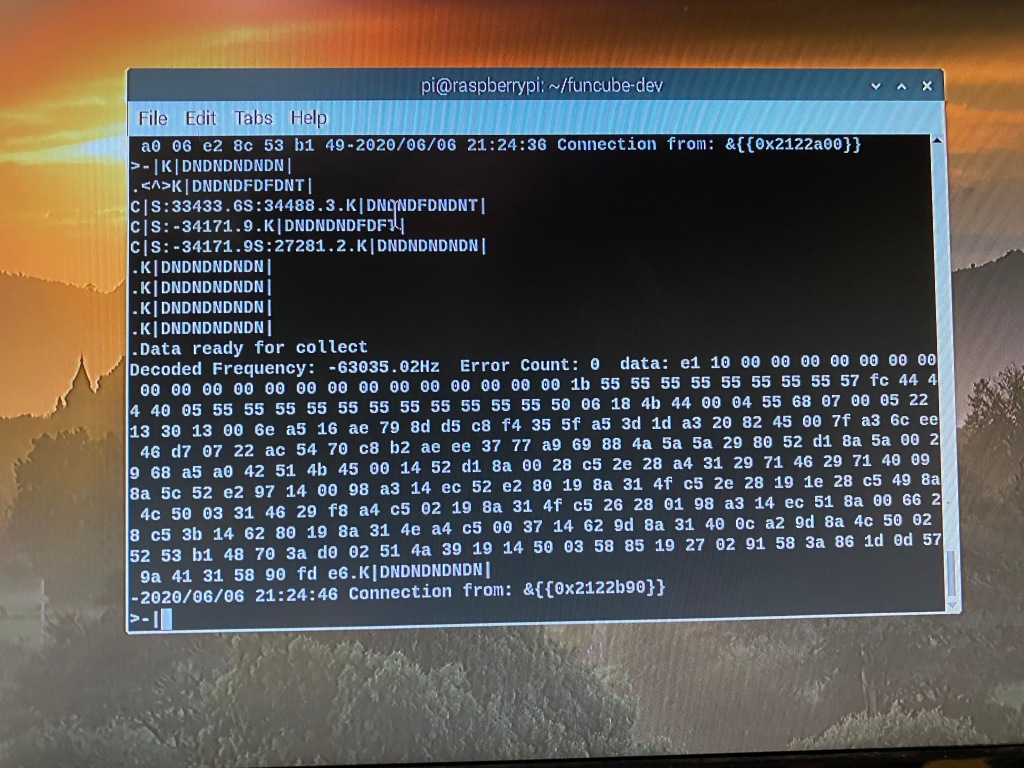
“Interactive Mode” is when the Telemetry Decoder operates in the foreground , when FUNcube compatible telemetry is received, the corresponding hex data is displayed on the terminal screen.
“Background Mode” allows the telemetry decoder to run as a Docker image in the background where it operates much like any other background service on Linux. This mode allows for the automatic restarting of the telemetry decoder after a shutdown or reboot of the Raspberry Pi, therefore making it suitable for a remote deployment situation.
*Both modes, when connected to the internet, will upload the received data to the FUNcube Data Warehouse and the totals displayed on the Ranking Page in the normal manner.
*Uploading to the warehouse requires registration with the FUNcube Data warehouse.
All the code for the telemetry decoder, and the scripts to build the Docker images, are now published online at the FUNcube-Dev GitHub account – https://github.com/funcube-dev under a GPL Open Source License.
Alternatively, it possible to buy a pre-formatted microSD card for the Pi from the AMSAT-UK shop here https://shop.amsat-uk.org/
Full instructions can be downloaded here
After some eight months in continuous sunlight, FUNcube-1 has now started to see some eclipses during each orbit.
The telemetry received has shown that the spacecraft continued to function perfectly during this period and the on board temperatures did not reach excessively high levels.
After this became clear, our next concern was the battery. Having been kept fully charged for this period, would it actually hold a charge and do its job when in eclipse?
After three weeks of increasing eclipse periods we can now see that indeed the Li battery appears to be ok and the bus voltage has not yet dropped below 8.1 volts.
So today we have changed the operating mode from high power telemetry educational mode to continuous amateur mode withe the transponder ON. The telemetry continues to be available, albeit at low power.
We will, of course, continue to carefully monitor the data but are planning to leave the spacecraft in this mode for at least the next week. Please enjoy using it!
Today, November 21st 2019, marks the sixth birthday of our very first CubeSat mission, FUNcube-1.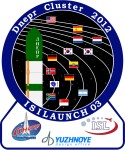 A very short time after the launch from Yasny in Russia and within a few minutes from deployment, the very first frame of data from the low power transmitter on board, was detected and decoded by ZS1LS in South Africa. He was able to relay the data over the internet from his Dashboard to the Data Warehouse and the numbers, appeared, as if by magic, at the launch party being held at the RSGB National Radio Centre at Bletchley Park.
A very short time after the launch from Yasny in Russia and within a few minutes from deployment, the very first frame of data from the low power transmitter on board, was detected and decoded by ZS1LS in South Africa. He was able to relay the data over the internet from his Dashboard to the Data Warehouse and the numbers, appeared, as if by magic, at the launch party being held at the RSGB National Radio Centre at Bletchley Park.
After a very brief check out, we were able to switch the transmitter to full power, again at the very first attempt, and were quite amazed at the strength of the signal from the 300mW transmitter on 145.935 MHz. The transponder was then switched on and successfully tested.
We finished the day with a request to AMSAT-NA for an Oscar number and were delighted to receive the AO73 Oscar 73 designation! 
Since then, FUNcube-1, with a launch mass of less than 1kg, has operated continuously with only a very few interruptions. In excess of 32000 orbits, 750 million miles travelled, and with more than 7 million data packets downloaded and stored in the Data Warehouse.
The spacecraft is presently in continuous sunlight and to convert as much of the sun’s thermal energy into RF (to help keep it cool), it remains in continuous high power telemetry mode. We anticipate this situation will continue until early May next after which we expect to have 3 months with some eclipse periods.
Of course, EO88 – Nayif 1 continues to operate autonomously with the transponder active when in eclipse and JO99 – JY1Sat, which includes image downloads, and which was launched just under a year ago, also remain active on a 24/7 basis.
We still receive many requests for Fitter message uploads for school events…please contact us by email to operations@funcube.org.uk giving us at least two weeks notice.
We continue to be very grateful to all the many stations around the world that continue to upload the telemetry that they receive to our Data Warehouse. We really need this data to provide a continuous resource for educational outreach.
With that in mind, here is a link to a previous update which shows the correct current Data Warehouse address and the Dashboard software that can be used for each spacecraft . https://funcube.org.uk/2019/01/21/funcube-dashboard-summary-update/

